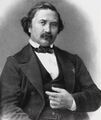Template:Selected anniversaries/April 5: Difference between revisions
No edit summary |
No edit summary |
||
| Line 2: | Line 2: | ||
File:Blaise_de_Vigenère.png|link=Blaise de Vigenère (nonfiction)|1523: Cryptographer and diplomat [[Blaise de Vigenère (nonfiction)]] born. The Vigenère cipher will be misattributed to him; Vigenère himself will devise a different, stronger cipher. | File:Blaise_de_Vigenère.png|link=Blaise de Vigenère (nonfiction)|1523: Cryptographer and diplomat [[Blaise de Vigenère (nonfiction)]] born. The Vigenère cipher will be misattributed to him; Vigenère himself will devise a different, stronger cipher. | ||
||1622 | ||1622: Vincenzo Viviani born ... mathematician, astronomer, and physicist. | ||
||William Brouncker | ||1684: William Brouncker dies ... mathematician who introduced Brouncker's formula, and was the first President of the Royal Society. Pic. | ||
||1722 | ||1722: The Dutch explorer Jacob Roggeveen discovers Easter Island. | ||
File:Joseph Lister 1902.jpg|link=Joseph Lister (nonfiction)|1827: Surgeon and scientist [[Joseph Lister (nonfiction)|Joseph Lister]] born. He will pioneer antiseptic surgery, performing the first antiseptic surgery in 1865. | File:Joseph Lister 1902.jpg|link=Joseph Lister (nonfiction)|1827: Surgeon and scientist [[Joseph Lister (nonfiction)|Joseph Lister]] born. He will pioneer antiseptic surgery, performing the first antiseptic surgery in 1865. | ||
| Line 16: | Line 16: | ||
File:Joseph Bertrand.jpg|link=Joseph Bertrand (nonfiction)|1900: Mathematician, economist, and academic [[Joseph Bertrand (nonfiction)|Joseph Louis François Bertrand]] dies. He worked in the fields of number theory, differential geometry, probability theory, economics and thermodynamics. | File:Joseph Bertrand.jpg|link=Joseph Bertrand (nonfiction)|1900: Mathematician, economist, and academic [[Joseph Bertrand (nonfiction)|Joseph Louis François Bertrand]] dies. He worked in the fields of number theory, differential geometry, probability theory, economics and thermodynamics. | ||
||1900 | ||1900: Archaeologists in Knossos, Crete, discover a large cache of clay tablets with hieroglyphic writing in a script they call Linear B. | ||
File:Havelock_and_Tesla_telecommunications_research.jpg|link=Havelock and Tesla Research Telecommunication|1910: Havelock and [[Nikola Tesla (nonfiction)|Nikola Tesla]] share Nobel Prize in Physics for [[Havelock and Tesla Research Telecommunication|research into electrical field modulation and data transmission]]. | File:Havelock_and_Tesla_telecommunications_research.jpg|link=Havelock and Tesla Research Telecommunication|1910: Havelock and [[Nikola Tesla (nonfiction)|Nikola Tesla]] share Nobel Prize in Physics for [[Havelock and Tesla Research Telecommunication|research into electrical field modulation and data transmission]]. | ||
||1933 | ||1933: Hjalmar Mellin dies ... mathematician and theorist dies. He is known for the Mellin transform. Pic. | ||
||Donald Lynden-Bell | ||1935: Donald Lynden-Bell born ... theoretical astrophysicist. He was the first to determine that galaxies contain supermassive black holes at their centres, and that such black holes power quasars. Pic. | ||
||Klaus Weber | ||1936: Klaus Weber born ... scientist who made many fundamentally important contributions to biochemistry, cell biology, and molecular biology. Pic. | ||
|| | ||1950: Marc Voorhoeve born ... mathematician who introduced the Voorhoeve index of a complex function in 1976. Pic: http://wwwis.win.tue.nl/~mvoorhoe/ | ||
|| | ||1951: Cold War: Ethel and Julius Rosenberg are sentenced to death for spying for the Soviet Union. | ||
|| | ||1958: Ripple Rock, an underwater threat to navigation in the Seymour Narrows in Canada is destroyed in one of the largest non-nuclear controlled explosions of the time. | ||
|| | ||1967: Hermann Joseph Muller dies ... geneticist and academic, Nobel Prize laureate. Pic. | ||
||Ralph Austin Bard | ||1969: Vietnam War: Massive antiwar demonstrations occur in many U.S. cities. | ||
||1975: Ralph Austin Bard dies ... financier who served as Assistant Secretary of the Navy, 1941–1944, and as Under Secretary, 1944–1945. He is noted for a memorandum he wrote to Secretary of War Henry L. Stimson in 1945 urging that Japan be given a warning before the use of the atomic bomb on a strategic city. He was "the only person known to have formally dissented from the use of the atomic bomb without advance warning." Pic. | |||
File:Howard Hughes 1940s.jpg|link=Howard Hughes (nonfiction)|1976: Businessman, investor, aviator, film director, and philanthropist [[Howard Hughes (nonfiction)|Howard Hughes]] dies. He was known during his lifetime as one of the most financially successful individuals in the world. | File:Howard Hughes 1940s.jpg|link=Howard Hughes (nonfiction)|1976: Businessman, investor, aviator, film director, and philanthropist [[Howard Hughes (nonfiction)|Howard Hughes]] dies. He was known during his lifetime as one of the most financially successful individuals in the world. | ||
||2004 | ||2004: Heiner Zieschang dies ... mathematician and academic. No pic. | ||
||Irving John Good | ||2009: Irving John Good dies ... mathematician who worked as a cryptologist at Bletchley Park with Alan Turing. After World War II, Good continued to work with Turing on the design of computers and Bayesian statistics at the University of Manchester. | ||
||2009 | ||2009: North Korea launches its controversial Kwangmyŏngsŏng-2 rocket. The satellite passed over mainland Japan, which prompted an immediate reaction from the United Nations Security Council, as well as participating states of Six-party talks. | ||
</gallery> | </gallery> | ||
Revision as of 16:17, 4 September 2018
1523: Cryptographer and diplomat Blaise de Vigenère (nonfiction) born. The Vigenère cipher will be misattributed to him; Vigenère himself will devise a different, stronger cipher.
1827: Surgeon and scientist Joseph Lister born. He will pioneer antiseptic surgery, performing the first antiseptic surgery in 1865.
1869: Physicist, mathematician, and engineer Sergey Chaplygin born. He will be known for mathematical formulas such as Chaplygin's equation, and for a hypothetical substance in cosmology called Chaplygin gas, named after him.
1870: Adventurer Wallace War-Heels publishes autobiography.
1900: Mathematician, economist, and academic Joseph Louis François Bertrand dies. He worked in the fields of number theory, differential geometry, probability theory, economics and thermodynamics.
1910: Havelock and Nikola Tesla share Nobel Prize in Physics for research into electrical field modulation and data transmission.
1976: Businessman, investor, aviator, film director, and philanthropist Howard Hughes dies. He was known during his lifetime as one of the most financially successful individuals in the world.






